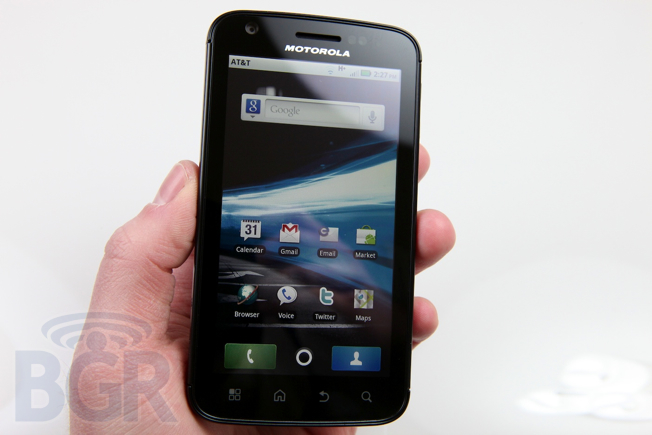The Motorola ATRIX 4G is the fastest smartphone not yet on the market. Come March 6th, however, it will be. AT&T has landed a screamingly fast Android device courtesy of Motorola, and that’s not all. The device is so powerful that it can power a laptop with full Firefox browser, and spit out 1080p video like it’s nothing. We’ve spent almost a day time with the phone and thought it was sufficient for a review, so read on past the break for what we think, alright?
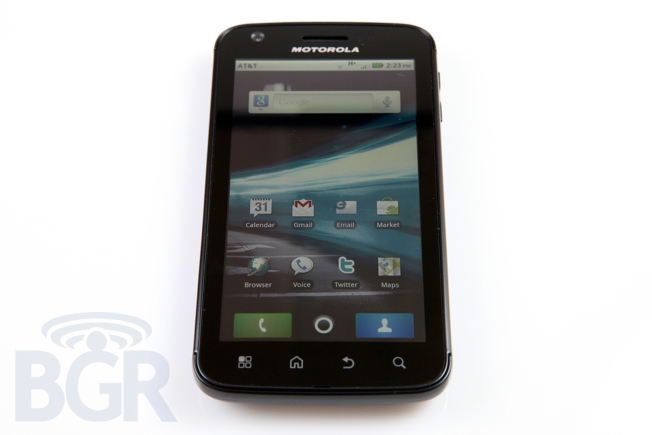
Hardware
The Motorola ATRIX 4G is one of the world’s fastest smartphone, literally. With a 1GHz dual-core Tegra 2 processor, it’s a screamer. So much so, it can power a full netbook-like laptop accessory (we’ll touch on that later). As far as other specifications go, it’s one of the few Android handsets to feature a whopping 1GB of RAM. Rounding out the feature set is a 5 megapixel camera with LED flash and 720p video recording, the first qHD (quarter HD) display, second microphone for noise cancellation, Wi-Fi, Bluetooth, front-facing video camera, HDMI port, and a fingerprint scanner for security that doubles as the on/off button.
When we picked up the ATRIX for the first time we were pleasantly surprised with how the materials felt. The device feels solid and well built, and we really love the size. It’s a tad bit thick, but since it’s nicely rounded on the edges, it feels thinner and more easy to hold than the HTC Inspire 4G to us, though the phone is incredibly slippery due to the matte black plastic casing. On the front of the ATRIX you’ll find the front-facing video camera in the upper left in addition to the proximity sensor, ambient light sensor, and notification LED on the upper right. Besides the four touch-sensitive Android menu keys on the bottom of the front, it’s pretty clean. Switching to the left side of the handset and you’ll find a microUSB port followed by a mini-HDMI port; on the right side of the phone there’s a volume up and down rocker. The on / off button is sneakily integrated into the fingerprint scanner on the top but towards the rear of the ATRIX, and while this bothered us a bit at first (only the inside part of the fingerprint sensor clicks in), it’s grown on us — plus we love using a fingerprint to unlock the handset. Moving to the back: you’ll find the 5 megapixel camera and LED flash, a reasonably cool carbon fiber-esque pattern on the rear battery door, and the rear external speaker on the bottom of the phone.
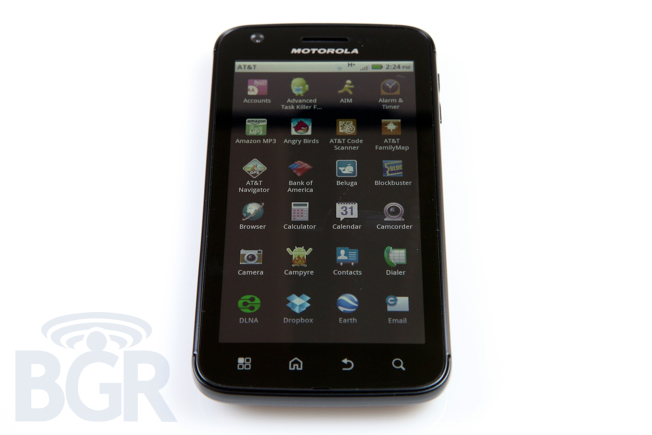
Display
The 4-inch display on the ATRIX packs a whopping 960 x 540 pixels into what Motorola is calling a qHD display. While the resolution is quite high, the display to us still looked pretty pixelated. It’s a little odd that the display on the Motorola DROID X actually looks better than the qHD display, in terms of clarity. Colors, however, look great and the panel is very bright and evenly lit. The screen on the ATRIX also fares very well in the touch sensitivity department with a solid and reliable capacitative touch screen.
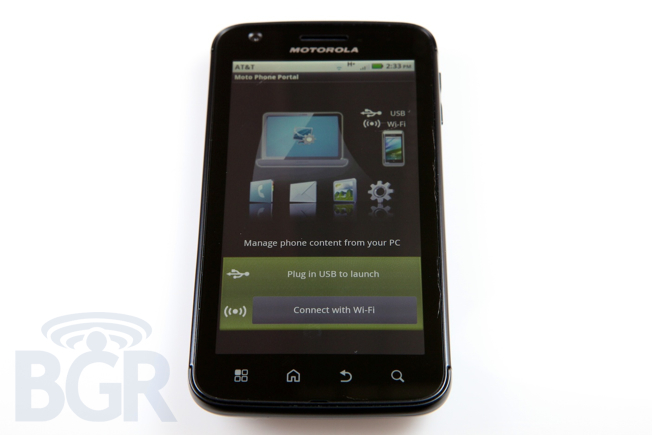
Software
The Motorola ATRIX 4G runs a version of the love-it-or-hate-it MOTOBLUR UI, and as much of an annoyance it can be sometimes, we’ve found that paired with the ATRIX, it’s not that big of a hindrance. Things run fast, smooth, and effortless, no doubt in thanks to that dual-core CPU, but again, the software UI on here isn’t that big of a deal, even if you are an Android purist.
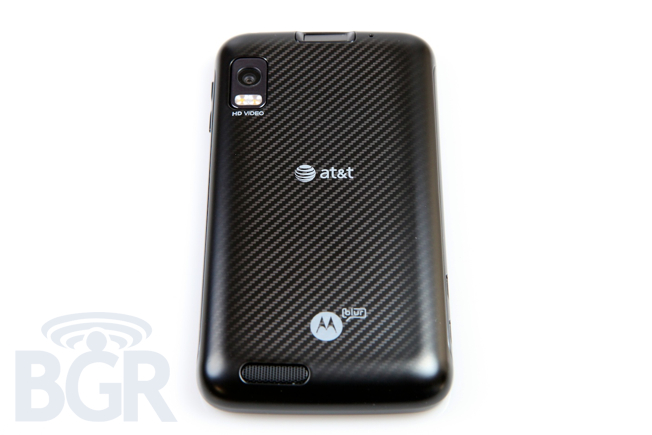
Phone / Speaker
Talking on the ATRIX was excellent. Calls were very clear with the internal ear speaker sounding very natural, and extremely loud. Noise cancellation also performed well in noisy environments helping people on the other line to hear us more clearly. We also really love the layout of the phone dialer screen — the most recent call/contact is right above the number pad, it’s a nice little touch. You also have the ability to add a number right from the dialer to your contact list, and you have a voice command button right next to that. We can’t remember if this happened on other Motorola devices, but when you go into contacts in the phone app, you’re presented with only your direct contacts in your synced address books, not the ones that are scattered about the actual contacts app (suggested contacts, Twitter contacts from BLUR, Facebook contacts from BLUR, etc.)
The speaker on the ATRIX performed very well in our tests. Music played back reasonably loud without much distortion, though it lacked that low end punch. The speakerphone also performed great, projecting audio loud and clear.
Battery
We’ve only been using the Motorola ATRIX for around a day now, but we can definitely report that the battery life on here seems to be pretty great. It’s easily on par or even a level better than other Android phones we’ve used and tested. We don’t do too, too much calling, but downloading, installing and using apps, email, browsing, Twitter, Facebook, and more hasn’t knocked us off the preverbal battery pedestal one bit.
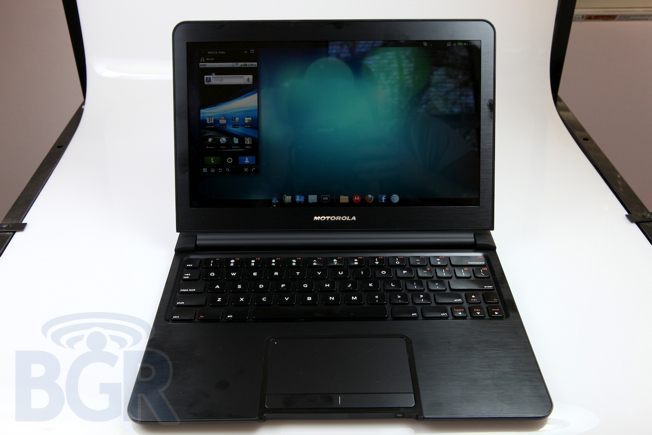
Laptop Dock
This is where the phone extends beyond a phone into something more, and it gets really interesting. As you might have heard and seen, the Motorola ATRIX has a couple accessory friends, and one of them is a laptop dock — a full fledged computer powered by the phone itself. Motorola told us that there is practically nothing in the laptop dock — no memory, no processor, nothing. In addition to containing basically an 11.6-inch screen, full keyboard, and built-in battery, the laptop dock actually doesn’t skimp on some essentials. The keyboard is backlit (who’d have thunk), there is an oversized trackpad, and it’s blended together in black aluminum and soft touch rubber.

A couple annoyances include the fact that the trackpad is not multitouch, which is a pretty big issue for scrolling — and we feel like a missed opportunity to extend gestures from the laptop dock to the phone. Since the phone literally runs and is displayed on the laptop screen in it’s own window, you have to literally click and drag your finger to swipe on the phone’s display — a nice little two finger swipe gesture would have been great there, for instance. It’s also very cumbersome to use the left and right mouse trackpad buttons as they are hard to push and don’t have great tactile feedback. Additionally, the black metal gets very, very smudgy and greasy even though we’re clean freaks and weren’t eating those delicious Lay’s Salt & Vinegar chips — we swear!
Speaking of the phone running on that laptop’s screen, this literally blows our minds. You have the phone displayed on screen and it’s directly manipulatable by you — you have the four Android buttons on screen, and can do anything you’d want to do from your phone. It’s also super useful as times since you get a full computing-like experience but still have your phone front and center to handle text messages, or whatever you’d want to do. The laptop dock uses the phone’s built in HSPA+ connection so there are no extra charges at all (provided you have the tethering/hotspot $20 plan), in addition to providing you with free AT&T Wi-Fi hotspot access wherever you might be. You also might be wondering what happens if you get a phone call when you’re connected to the laptop… you can make and take calls just fine. The phone goes into speakerphone and Motorola let us know that a built-in microphone was optimized for this mode and we do have to say, it works really well.

The initial honeymoon period with the laptop dock quickly wore off, and here’s why… When purchased with the ATRIX, the laptop dock is bundled for $499 ($199 for the device, $299 for the laptop dock). Purchased separately, the laptop dock is priced at $499. Let’s throw out the possibility of buying the laptop dock separately since in our minds, that’s out of the question. The question is if the laptop dock — a single purpose accessory for your smartphone — is worth $300, and we’d unfortunately have to say that we don’t think it is. While on paper it sounds great, and even in person it looks amazing, most of the excitement is lost when you use the laptop dock. We aren’t in love with the keyboard or the trackpad, and navigation was a frustrating experience for us. Not because of the software or processor, but because of the hardware on the laptop. Additionally, while you have your phone front and center with a full-fledged Firefox browser, that’s all you get and that’s not going to be enough for most people. Especially when for $300-$500 you can buy a pretty solid netbook-like device that will do much more than extend your smartphone — it will be a full computer which can be used with your ATRIX’s mobile hotspot feature.
One last thing about the laptop dock which we loved: there’s a built-in battery and that battery powers the laptop dock in addition to the phone. So think about this… you charge the laptop dock, jump on a plan, work on Wi-Fi for 5 hours, grab your phone and close the laptop when you land, and your phone is fully charged. Pretty impressive to us.
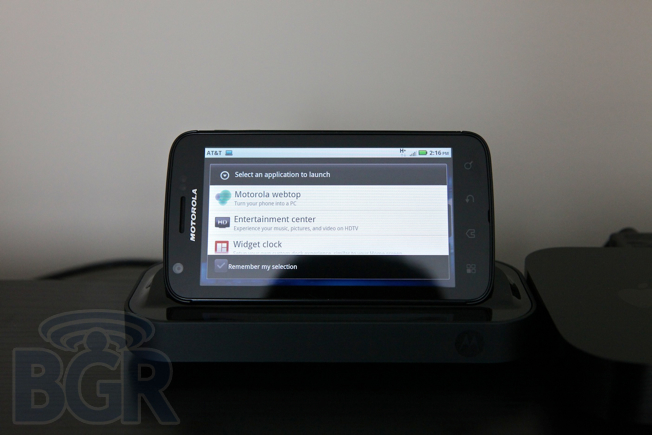
Media Dock
The Motorola Media Dock is another accessory friend the Motorola ATRIX works with, and it’s pretty nifty. The dock connects to your TV with an HDMI cable and extends the device to your home entertainment center with little effort. You can browse and play your music, photos, and HD videos right from the phone, even 1080p video content plays back just fine. There’s one more piece to the puzzle, however. The media dock also lets you run Motorola’s webtop app experience and will save the state you’re in whether you are using the laptop dock or media dock, which is very cool. This is the same concept that the laptop dock features — your phone in a window on the big screen with the application down at the bottom and the full Firefox browser. Navigating with the included remote is a non-starter, so what’s a man to do to get his big screen, dual-core smartphone-powered, browsing on? Well, you can connect a USB mouse and keyboard, but that’s not ridiculously fun, so Motorola has a Bluetooth keyboard you can purchase which works great in this set up.
UPDATE: We’re waiting for clarification on if the media dock comes with the Bluetooth keyboard and mouse

The Verdict
The Motorola ATRIX 4G is a very impressive product that brings an impressive set of accessories and peripherals to market that extend the smartphone into something much, much more. Looking at the phone specifically, it’s a feature-packed Android 2.2 device that has a vivid, high resolution screen, and a screaming fast dual-core CPU making it the fastest phone in the market. We didn’t honestly notice the phone to be that much faster than normal 1GHz-powered handsets, except under extreme circumstances, but that’s expected. We’d say without question that the Motorola ATRIX 4G is one of the best Android smartphones to ever be available from AT&T. The accessories it brings with it aren’t going to push you to buy the smartphone, but the concepts are pretty wild and really do widen your eyes and make you step back to see what cellphones nowadays are capable of doing, and doing well. The fact we’re at a time where a phone can power a full computer is incredible, and it’s great to see a fine device like the ATRIX 4G be the first to do it. If you’re ready to go, you’ll have to wait just a little longer to get your hands on one, as the device is available for pre-order starting this Sunday and is set to be released on March 6th for $199.


